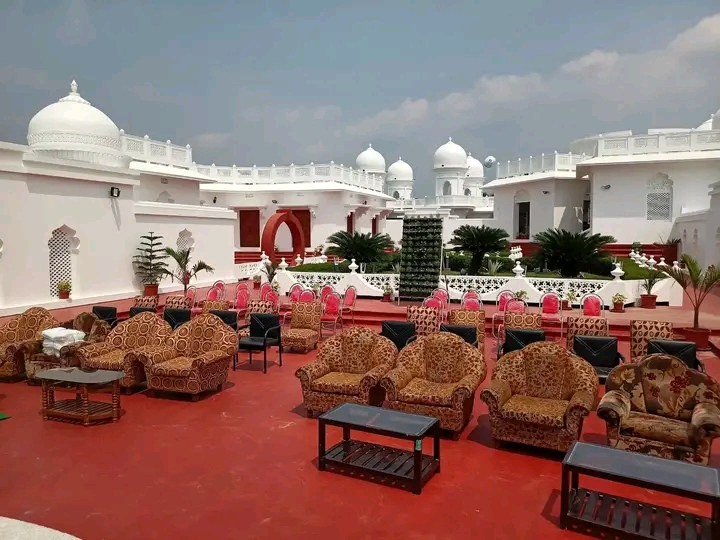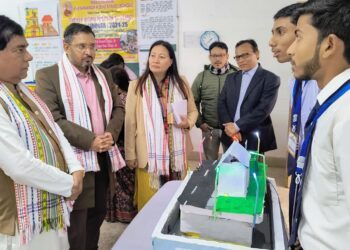Agartala, May 04, 2021: Internationally acclaimed ‘Rudrasagar’ lake in Tripura is one of India’s 27 Ramsar sites has lost its decades old glory as it had completely dried up due to no drop of rain for the past 9 months. A committee formed to protect it by the state government had to release excess water every year from the lake to protect the vested interest of stakeholders and fishermen, who are earning their livelihood by fishing and agricultural production.
Altogether, two such water palaces are there in India. One is Neer Mahal in ‘Rudrasagar’ lake of Tripura and another one is Jal Mahal in Udaipur of Rajasthan. But the water area of ‘Rudrasagar’ lake is more attractive than Jal Mahal. However, its glory gradually went down since 1978 when the Left Front government led by Chief Minister Nripen Chakraborty allowed the people for fish and agriculture production.
The Ministry of Environment and Forest has identified ‘Rudrasagar’ lake as one of the wetlands of National Importance for conservation and sustainable use on its biodiversity and socio-economic significance. Even Ramsar Convention declared this lake, only one in Tripura, as a wetland of international importance way back in 2005.
During the erstwhile Left Front government’s regime in Tripura, a dredging machine was procured in 2015 to dredge out huge quantities of siltation from the ‘Rudrasagar’ lake. Even the government brought an expert to train two persons for running and utilizing this dredging machine. But due to negligence of government administration, the dredging machine has been left abandoned for more than three years. Hence, no desiltation process was carried for the last three years, causing massive storage of new mud flowing through perennial streams and the Gomati river every year.
Speaking with NEindia.com, the secretary of Rudrasagar Udbastu Fishermen Samannay Samiti (RUFSS) limited Parameshwar Das said “It is difficult to preserve water during the rainy season in ‘Rudrasagar’ lake. However, if the natural rain water is conserved, then this ‘Rudrasagar’ lake would never face such miserable consequences. But the stakeholders are dependent on the ‘Rudrasagar’ lake and accordingly, excess water is released through switch gates in different streams connected with this lake”.
“We have never seen such a bad situation in our lives. Nine months passed off, but no rain. About 5 to 7 years back, this kind of drought was noticed by the people here, but not like this time. Now, the depth of water level is very low. This path of the waterway towards Neer Mahal is dangerous. Even the fish production will be facing terrible consequences in the coming days. The Fishery department gave minnows this year, and we also provide minnows from our funds. Huge quantity of minnows has been poured in ‘Rudrasagar’ lake. However, the present situation has become tough for the survival of fishes in this lake. The condition is highly miserable. All sights are dried up”, said Parameshwar.
“There are three streams flowing water to this lake, near Gomati district hospital, Padmanagar before Bishramganj, and another one from Durlovnagar village. From these three perennial rivers, huge quantities of water flow to ‘Rudrasagar’ lake during monsoon season. Since the Durga Puja celebration last year, till now water did not flow in this lake through those streams”.
“Siltation is one of the major reasons behind drying up of the huge lake. About 11 meters was the depth of the ‘Rudrasagar’ lake during its inception in 1930 when Maharaja Bir Bikram Kishore Manikya Debbarma constructed this place in the middle of the lake. After 1949, many people fled from erstwhile East Pakistan, now Bangladesh arrived here, cleared forest and built their mud-baked houses. Naturally, if forest is cleared and the environmental ecosystem is disturbed then land erosion takes place in bigger form. Accordingly, the perennial rivers flow huge quantities of silts during the rainy season and fall or are stored in ‘Rudrasagar’ lake”, he added.
Citing the decrease in water level and area of the ‘Rudrasagar’ lake, the RUFSS secretary said “In 1983, a big flood took place here, and large portion of the Agartala Sonamura road was broken which led to huge quantity silts flowing through Gomati river arrived and stored at ‘Rudrasagar’ lake. Even people’s houses made of mud-baked walls were collapsed and stored in this lake. 7-8 feets of siltation filled this lake. Hence, the water height level decreases. Constant rainfall took place earlier for 5-7 days, but now such things of weather are never noticed. People also became self-reliant with a belief that the water level will not escalate to higher heights. Another big flood also took place in 1993. After that, people residing in Melaghar and beside ‘Rudrasagar’ lake, did not witness such floods anymore. Now, with little rainfall it has been seen that the water level escalates and touches the courtyard of nearby houses constructed around ‘Rudrasagar’ lake”.
“Beside this large water body, paddy-cum-fish culture is maintained. On all the sides, paddy is cultivated immensely. Speaking about fish culture, the water body is neither rectangle nor square in size. This water body has numerous narrow streams formed naturally. On the mouths of those streams, artificial small-size dams were formed by the people to restrict fishes out from this lake. If the water in this lake does not decrease then, it becomes difficult for fishing for the interest of fishermen and farmers as they cannot do farming. Hence during the rainy season, it is not possible to hold the entire quantity of water in this lake. If this natural rain water is preserved then this ‘Rudrasagar’ lake would not have faced such miserable consequences. But the stakeholders are dependent on the society. Now, the environment is not dependent on people, rather people are”, he also added.
Parameshwar said “About 2000 stakeholders reside around ‘Rudrasagar’ lake. There are many families who are not stakeholders, also residing around this lake. They are dependent on this lake indirectly. The local fish produced are sold in local markets. If the fish production is high, then sold in other markets of the state. But the way the water has dried up, the fish production will be affected immensely”.
Sharing the problems faced by the Samiti and stakeholders, he said that they cannot maintain accounts on fish production from this lake. The society gave lease to the stakeholders. After taking the lease, what quantity of fish he had sold, that we can’t say. Earlier, the society had another process for earning benefits where fishermen get 60% and society receives 40%. It is seen that the fishermen do not inform the actual quantity of fish produced. Hence, a fixed rate for fishermen has been formed. But the lease rent given by the fishermen/stakeholders. Fishing permits are also being given and the society takes the fee. The society earns Rs 1.50 crore per annum from the stakeholders. However, there has been no farming from April to September last year due to COVID-19 pandemic. Apart from this Rs 50-60 lakh is the gross income based on tourist footfalls and expenditures include maintenance of boats, diesel, salaries, etc. while Rs 40 lakh lease received by the society per annum.
Expressing dissatisfaction over the dry season for the past 9 months, RUFSS limited president Pabitra Kumar Das told NEindia.com that the fishes take birth and grew naturally in ‘Rudrasagar’ lake will not be able to grow this time as the water level had decreased which in turn incurred loss of crores of resources. Above all, this time the stakeholders around ‘Rudrasagar’ lake will be incurring huge loss as already the second wave of COVID is rampant across the country which is also far more dangerous than the previous year.
Pabitra said, the central government as per the Ramsar convention is liable to protect and develop the biodiversity of the ‘Rudrasagar’ Lake in Melghar, western Tripura. Even the High Court also gave order of initiating dredging work at the earliest and at least, two metres of siltation should be dredged out. Initially, there have been 9 metres depth of water level, but presently it is far less which is difficult to move boats and fishing issues.
He said the government documents revealed that a ring road should be passing through the villages all around ‘Rudrasagar’ lake. But the previous government, employees and officers did not pay any heed to the order and took the wrong decision, poured mud within the water body to construct a ring road around it. Recently a judge of Delhi High Court visited ‘Rudrasagar’ lake and was shocked to see the move of the state government in the illegal process of filling up the sides of the lake. He also raised voice how the government is misusing crores of money released by Ramsar Convention in filling up the internationally acclaimed lake. Immediately, advocate Indrajit Chakraborty filed a case in the High Court of Tripura. The bench of Chief Justice Sanjoy Karol gave verdict and clearly mentioned that the soil at the banks of ‘Rudrasagar’ lake have to be lifted and dredging works should also be started immediately.
The Union Forest and Environment Ministry had earlier declared ‘Rudrasagar’ as the 13th national lake, which covers an area of around 5.3 sq kms and is home to a variety of migratory birds and flora and fauna.
Former Chief Engineer of the Water Resource Department Tapan Lodh in November 2019 said that the ‘Rudrasagar’ Wetland Development Committee (RWDC) headed by the Tripura Chief Secretary had over the past few decades remained casual about this vital issue leading to a serious situation now. “The RWDC should have conducted a study and taken suitable measures to protect and develop the hydrological, environmental and economic (livelihood) balance of the ‘Rudrasagar’ Lake. Protection of diverse flora and fauna and varied fishes of the water body was extremely vital, but nothing was done,” he added.
It may be mentioned here that Mukta Mancha, a social organization had fought to restore its grandeur, but failed due to indifferent attitudes of the successive state governments.


















